iOS Applications (apps) for Attention Deficit Hyperactivity Disorder (ADHD/ADD): a preliminary investigation from Australia
Kavindu Kumaragama1, Pradeepa Dasanayake, MBBS, MD, FRANZCP2
1Undergraduate in Biomedicine at the University of Melbourne, Victoria, Australia; 2Consultant Psychiatrist, The Melbourne Clinic, 130 Church Street, Richmond, Victoria, Australia
Corresponding author: pradeepa.dasanayake@mh.org.au
Journal MTM 4:2:33–39, 2015
Background: Mobile health tools are currently available for both clinicians and patients. However, there were no published articles related to Attention Deficit Hyperactivity Disorder (ADHD) applications for smartphones or tablets.
Aim: Provide information in relation to apps available from iTunes store for managing ADHD.
Methods: A literature search was performed. The Australian iTunes App Store and Google were searched with the keyword ADHD. Only apps from the iTunes Store were downloaded and tested. Categorisation was done in order to elucidate their functionality.
Results: 32 apps were found and compared in ratings, functionality and cost. There were no customer ratings or reviews on any of the ADHD applications. Applications were categorised according to functionality. The cost ranged from free to $10.49.
Conclusion: Apps specific to ADHD are available for suitable electronic devices. These provide education assistance with diagnosis and monitoring of the condition. The basic costs range from free of charge to $10/-. Information is provided to assist in selecting applications based on the need of the user.
Introduction
Attention Deficit Hyperactivity Disorder (ADHD) is a neurodevelopmental disorder characterised by Hyperactivity and Inattention1. It is a condition that begins in childhood and continues into adulthood. The prevalence in adults is noted as 3–6%2–4 with about 5–10% in children5. These data were derived from general population studies. Polanczyk and others in a meta-regression noted a prevalence of 5.3% in children6. Distractibility and short attention span are well known features of ADHD1,7. Hence, those with the condition benefit from prompts, assistance with planning, and timely reminders. Smartphone applications (apps) were considered as one source of such help in the current climate where smartphones are increasingly being used.
1.2 billion people worldwide were using mobile apps at the end of 2012. This is forecast to grow at 29.8 percent each year, to reach 4.4 billion users by the end of 20178. In 2012, approximately 46 billion apps from the iTunes App store were downloaded, while in 2013, this number was 82 billion, almost double9.
Whalen and others have reported on the use of electronic diaries in studies of ADHD10,11. Porter and others found that computer based data entry was superior to paper based systems12. Although such studies have been reported we did not find any scholarly articles In PUBMED or Google scholar with searches using key words Apps and ADHD. On the other hand, a recent study highlighted the popularity of smartphones and apps for their education and clinical work13. However, limitations in relation to iPhone apps and the paucity of research in relation to their development from a limited survey were noted 14.
A component of ADHD is difficulty in focussing attention, leading to functional problems. Since there is a growing popularity of smartphone and ready availability of applications that can assist in various tasks, we decided to review the apps with ADHD in their subject heading in order to ascertain their functionality both for the patient and clinician. On reviewing the literature there was a paucity of scholarly articles dealing with the use of smart phone applications.
Methods
The search engines used in relation to the literature search were PUBMED and Google Scholar. The key words used in the search were “adhd apps”, “adhd applications”, and “adhd iphone apps”. Although there were numerous papers retrieved none of them had any connection between the use of smart phone apps and ADHD. In order to locate applications the search engine Google and the iTunes App store were searched. In Google we searched with the key words “Android ADHD apps”. On the iTunes App store the key words “adhd apps” were used. Although there were numerous applications that were retrieved in the iTunes app store we selected only those apps with the word ADHD in their title. There were 32 apps in the iTunes app store which had ADHD as part of the title. There were 12 Android ADHD applications found after completing the Google search15 with the phrase “android adhd apps”. All searches were performed by one of us (KK) in January 2014.
All of the apps retrieved from the iTunes app store were downloaded and tested on the applicable device (iPhone and iPad). However, due to constraints, the testing and reviewing was only conducted on Apple iTunes Store applications. Applications were then classified in order to delineate their functionality.
Results
Of the 32 apps that were identified seven could be used only with an iPad (Table 1). Most of the apps were under 100 MB. The majority of them ranged from 1 MB to 40 MB.
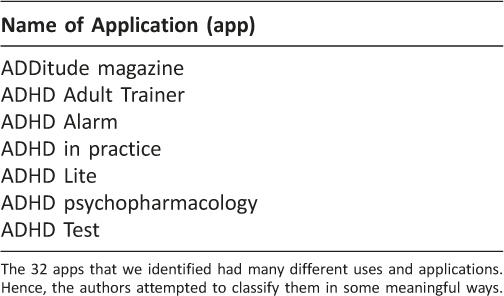
Table 1: Apps for iPad only
Cost
Almost all the apps were free to download, but the higher quality apps tended to cost more. The most expensive apps found were ADHD Treatment and ADHD Psychopharmacology which cost $10.49.
The mean cost for all the apps was AUD $1.88. There were some apps that were also upgradeable to a paid version where the advertisements were removed and more cognitive training games were collected. There was one app, ADDitude Magazine, which utilised the function of in-app purchases. Although it is a free app to download, if the user wishes to use the app then payment is required. The cost is $20.99 annually in order to download the articles published. The Figure 1 is a graphic representation of the costs. A detailed breakdown of the cost for each app is provided in Appendix 1.
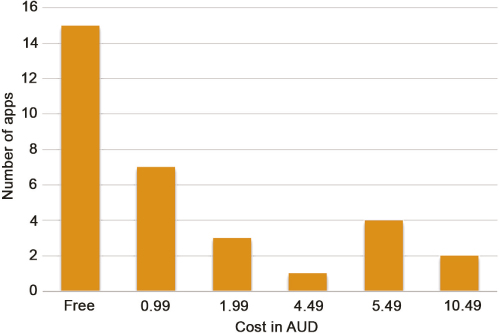
Figure 1: Cost of applications
Functionality
All of the applications had an educational component, with the exception of ADHD 2013 which gave information only relating to ADHD conferences. The apps were further classified into categories that indicate their usefulness in various situations. Built into many of the apps were smartphone tools that allowed the user to remind them to complete daily activities or enhance brain activity so as to improve their condition. There were two major utility functions that were selected from among the applications i.e. apps that assisted with diagnosis and ones that enabled the individual user to monitor progress by creating a profile.
‘Diagnostic Apps’: Assists the individual and/or the clinician to evaluate the diagnosis of ADHD (Table 2)
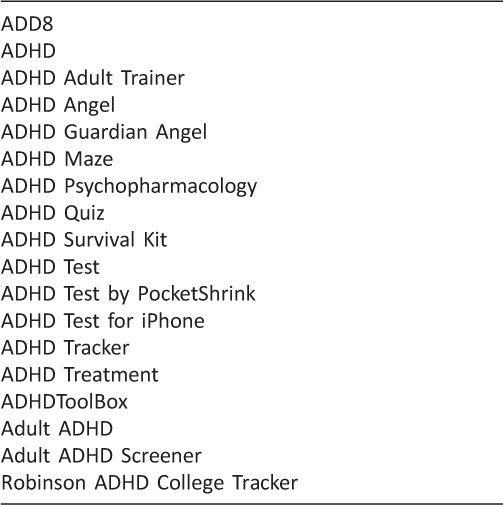
Table 2: Applications aiding diagnosis
‘Profiling Apps’: Allows users to create their own personal profile that can be accessed by them or others only who have been granted permission. Hence, they were helpful in monitoring the progress of the individual (Table 3).
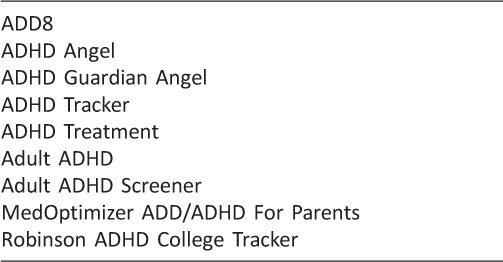
Table 3: Applications that allow creation of creation of a profile
The applications were further categorised in order to delineate functionality. This would then be helpful both to the patient and clinician (Table 4). The app names and which each of the category/ies they belong to is in Appendix 2. There are apps that feature in more than one category and this is due to their versatility.
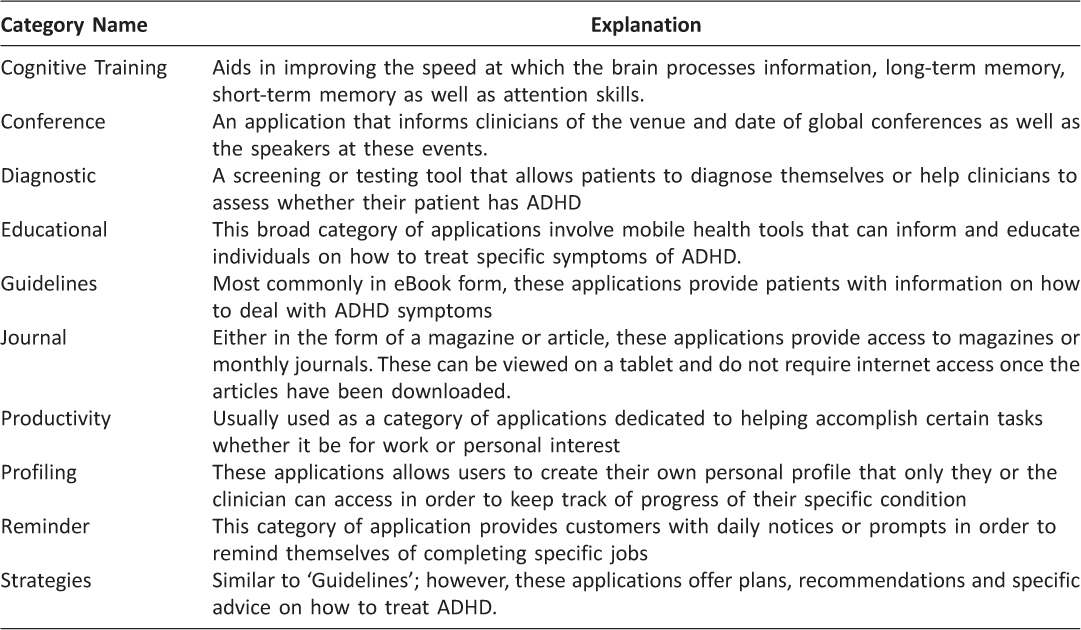
Table 4: Explanation of categories for applications featured in Appendix 2
The ADHD Treatment app provided many functions such as a ‘Daily Treatment’ record and treatment games as well as sections for clinicians and patients that inform them of what ADHD is and how it can be treated. It is, therefore, in our view, the most versatile app. It is useful for both the clinician as well as the person who is attempting to control the symptoms.
Discussion
In the search for literature when the “Attention Deficit Hyperactivity Disorder” was used there were articles whose primary focus was not necessarily dealing with the condition and when the abbreviation ADHD was used the search once more yielded the studies with the condition. Hence we are of the view that use of ADHD is a more elegant option compared with using, “Attention Deficit Hyperactivity Disorder” as a search terms. Furthermore the term ADHD was used, as this is the current terminology as per DSM IV1. Although there were no articles related to ADHD apps, the use of electronic devices10 and web based systems in ADHD had been discussed16. The use of computerised decision aiding systems enhanced management in children with ADHD when compared with those who did not have the intervention17. Applications are viewed as an extension and enhancement to aforementioned work. The apps we reviewed varied in their usefulness and functionality. The degree of user-friendliness is likely to depend on the individual’s capacity to be technologically competent. The need for use of electronic methods has been highlighted using ADHD as an example18.
Most of the apps analysed during the research focused on the broad range of ADHD symptoms that patients require help with. The categories allow patients and clinicians to be aware of the vast array of different ADHD apps on the market. The subdivisions of the broad categories would further assist patients and clinicians in determining which apps are most suitable to their symptoms and needs. According to US databases, clinical treatment as well as medication for ADHD received by an individual can cost between USD 12,000 and 18,000 annually19.
The majority of the apps did not offer users the chance to record data or their health progress. Instead, they provided one test to confirm their condition and therefore the app became redundant after just one use. We would, therefore, consider these as having limited utility value. However, they do provide a role in the ADHD gestalt.
Some common issues such as sleep problems faced by ADHD patients20 were not addressed in the apps that were reviewed by the authors. However, such problems, although associated with the syndrome, are not part of the core symptom profile. Harrison and Goozee21 in their brief review found that psychiatry related apps in general were not based on theoretical principle and costs were identified as a deterrent factor in their utilisation. Our findings varied in that these apps were specifically based for ADHD and there were a number of apps that were free to the user.
Management of ADHD is multi-faceted22. Smartphone or tablet apps would form part of the treatment armamentarium. Hence, these mobile applications can help patients improve their productivity as well as provide more information and knowledge about their condition. Awareness on the part of the clinician and patient will enhance and add value to the management regime.
Although iPads and iPhones are widely used, we acknowledge that reviewing apps only from the Apple iTunes App Store is a limitation of this study.
Conclusion
ADHD apps for both iPad and iPhone are available with some that can be used only on the iPad. They assist in diagnosis, providing information, skill training, acts as aide de memoirs, and assists individuals in monitoring their condition. Most apps incorporated several of these functions. The basic costs vary between $0.00 and $11.00. App users need to select the most suitable based on their need. Evaluation of apps that are used on Android devices is made as a suggestion for future research.
Acknowledgement
We would like to thank Dr. Mahendra Perera (Consultant Psychiatrist) for giving us the idea and assisting us at various stages of the project.
REFERENCES
1. American Psychiatric Association. Diagnostic and Statistical Manual of Mental Disorders (4th ed., text rev.). Washington, DC: American Psychiatric Publishing, Inc.; 2000. doi:![]() .
.
2. Das D, Cherbuin N, Butterworth P, et al. A Population-Based Study of Attention Deficit/Hyperactivity Disorder Symptoms and Associated Impairment in Middle-Aged Adults. (E. M. C. Skoulakis, Ed.) PLoS ONE, 2012;7(2):e31500. ![]()
3. Fayyad J, De Graaf R, Kessler R, et al. Cross-national prevalence and correlates of adult attention-deficit hyperactivity disorder. The British Journal of Psychiatry 2007;190(5):402–9. ![]()
4. Michielsen M, Semeijn E, Comijs HC, van de Ven P, Beekman ATF, Deeg DJH, Kooij JJS. Prevalence of attention-deficit hyperactivity disorder in older adults in The Netherlands. The British Journal of Psychiatry 2012;201(4):298–305. ![]()
5. Scahill L, Schwab-Stone M. Epidemiology of ADHD in school-age children. Child and Adolescent Psychiatric Clinics of North America. 2000;9(3):541–555.
6. Polanczyk G, de Lima MS, Horta BL, Biederman J, Rohde LA The worldwide prevalence of ADHD: A systematic review and metaregression analysis. Am J Psychiatry 2007;164:942–8. ![]()
7. Hallowell, E.M. and Ratey, J.J. (1995) Driven to distraction. New York: Touchstone. ISBN 0-684-80128-0
8. ABI Research – How many mobile apps are downloaded each year? (2013); http://mobithinking.com/mobile-marketing-tools/latest-mobile-stats/e (accessed 19th January 2014)
9. Murphy JM, Masek B, Babccok R, Jellinek M, Gold J, Drubner S, Sklar K, Hacker K. Measuring outcomes in outpatient child psychiatry: the contribution of electronic technologies and parent report Clin. Child Psychol. Psychiatry 2011;16:146–160. doi:![]()
10. Whalen CK, Henker B., Ishikawa SS, Floro JN, Emmerson NA, Johnston JA, Swindle R. ADHD and Anger Contexts: Electronic Diary Mood Reports from Mothers and Children. Journal of Pediatric Psychology 2009;34(9):940–53. ![]()
11. Whalen CK, Henker B, Ishikawa SS, Emmerson NA, Swindle R, Johnston JA. Atomoxetine Versus Stimulants in the Community Treatment of Children With ADHD: An Electronic Diary Study. Journal of Attention Disorders 2010;13(4):391–400. ![]()
12. Porter SC, Guo C-Y, Bacic J, Chan E. Health Literacy and Task Environment Influence Parents’ Burden for Data Entry on Child-Specific Health Information: Randomized Controlled Trial. Journal of Medical Internet Research 2011;13(1):e13. ![]() .
.
13. Payne KFB, Wharrad H, Watts K. Smartphone and medical related App use among medical students and junior doctors in the United Kingdom (UK): a regional survey. BMC Medical Informatics and Decision Making 2012;12(1):1. ![]()
14. Harrison AM, Goozee R. Psych-related iPhone apps. J Ment Health. 2014;23(1):48–50. ![]()
15. https://play.google.com/store/apps/details?id=com.mobihypnos.soft.add&hl=en (accessed 5th February 2014)
16. Palmer NB, Myers KM, Vander Stoep A, McCarty CA, Geyer JR, DeSalvo A. Attention-Deficit/Hyperactivity Disorder and Telemental Health. Current Psychiatry Reports 2010;12(5):409–417. doi:![]() .
.
17. Baum RA, Epstein JN, Kelleher K. Healthcare Reform, Quality, and Technology: ADHD as a Case Study. Current Psychiatry Reports 2013;15(7):369. doi:![]() .
.
18. Carroll AE, Bauer NS, Dugan TM, Anand V, Saha C, Downs SM. Use of a Computerized Decision Aid for ADHD Diagnosis: A Randomized Controlled Trial. Pediatrics 2013;132(3):e623–9. doi:![]()
19. Economic Costs. 2013. http://www.cdc.gov/ncbddd/adhd/data.html (accessed 30th January 2014)
20. Konofal E, Lecendreux M, Cortese S. Sleep and ADHD. Sleep Med 2010;7:628–52. doi: ![]() .
.
21. Harrison AM, Goozee R. Psych-related iPhone apps. Journal of Mental Health 2014;23(1):48–50. doi:![]() .
.
22. NIMH Multimodal Treatment Study. (2009) http://www.help4adhd.org/en/treatment/guides/mta (accessed 8th February 2014)
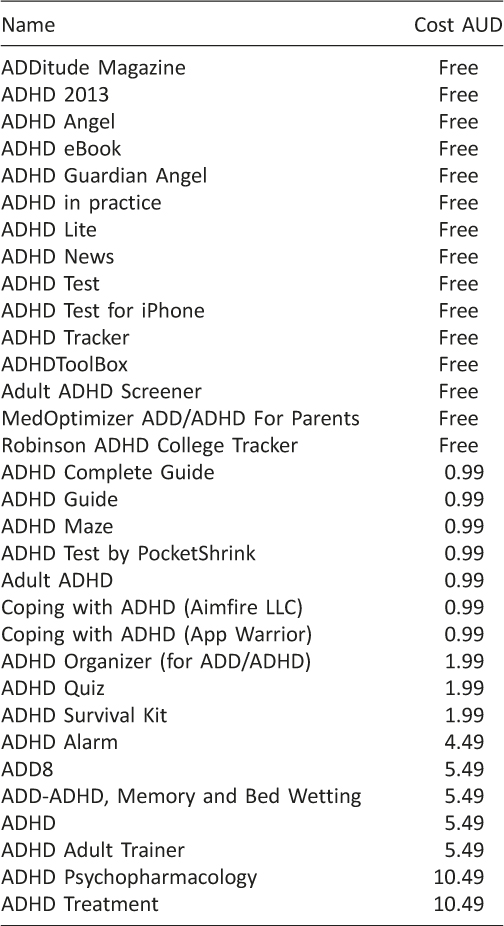
Appendix 1: Cost of Applications
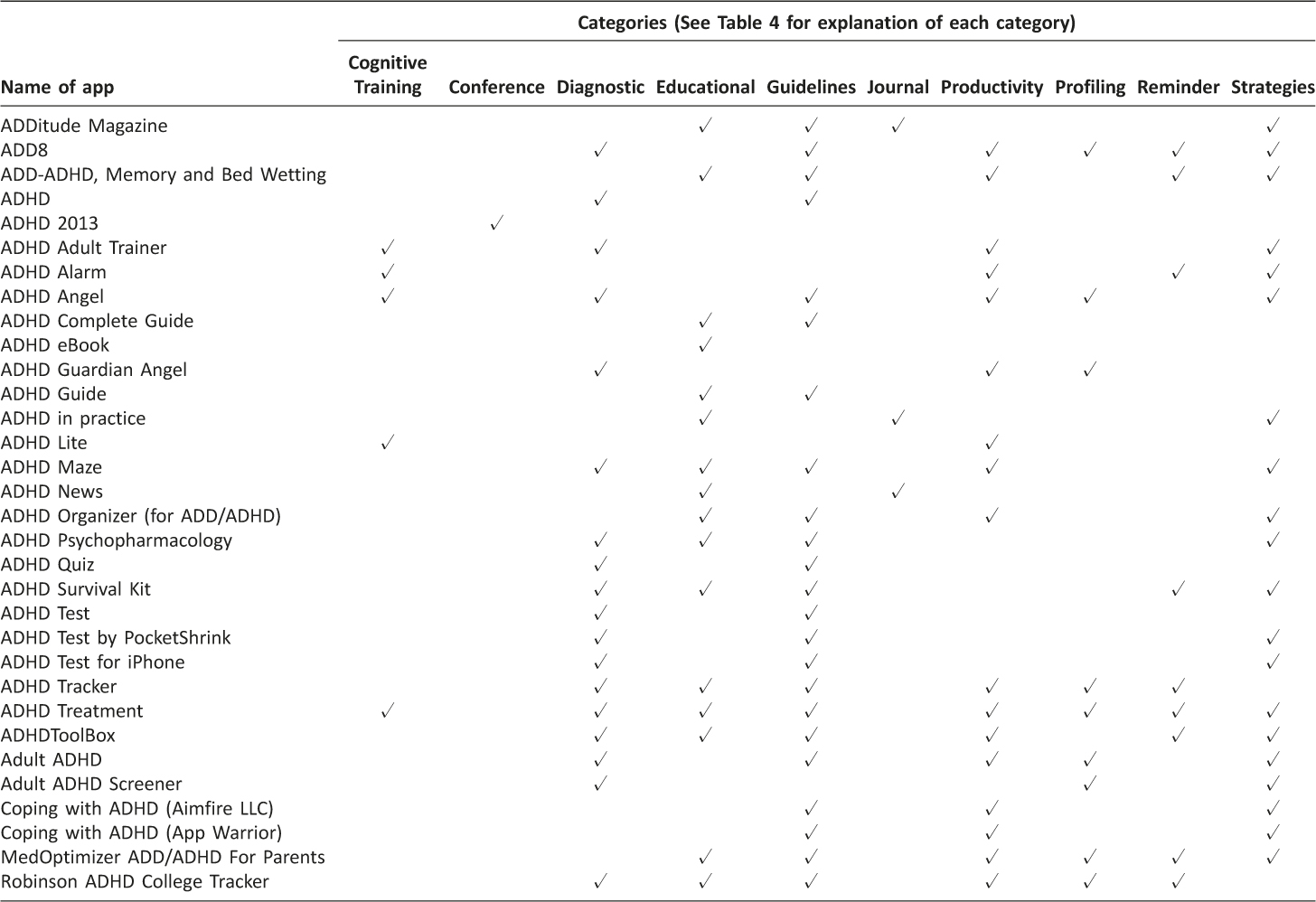
Appendix 2: More detailed classification of Apps

